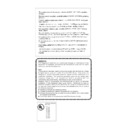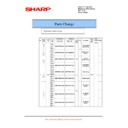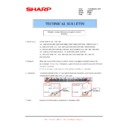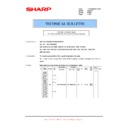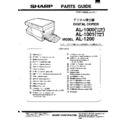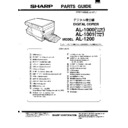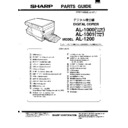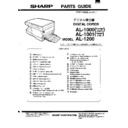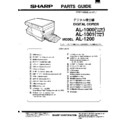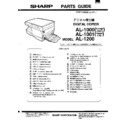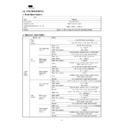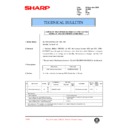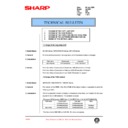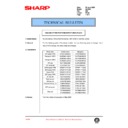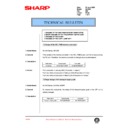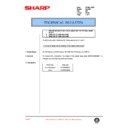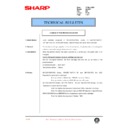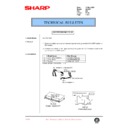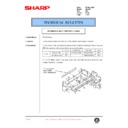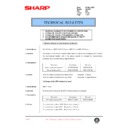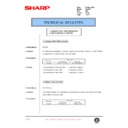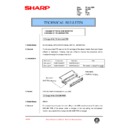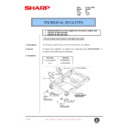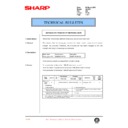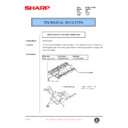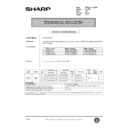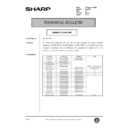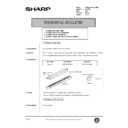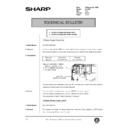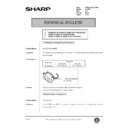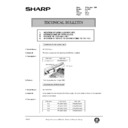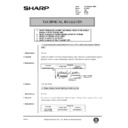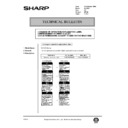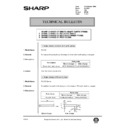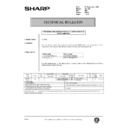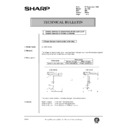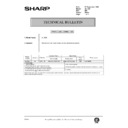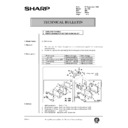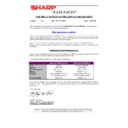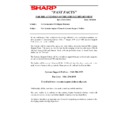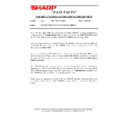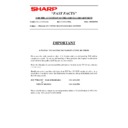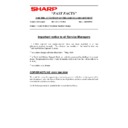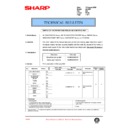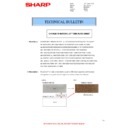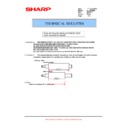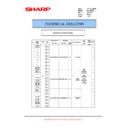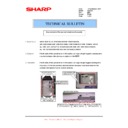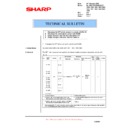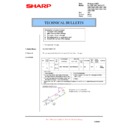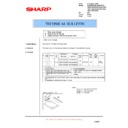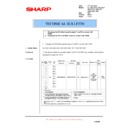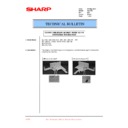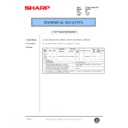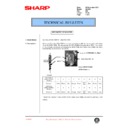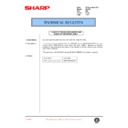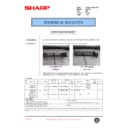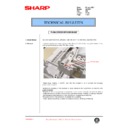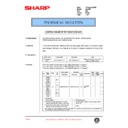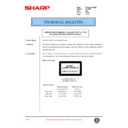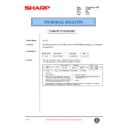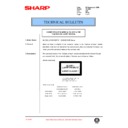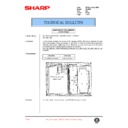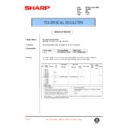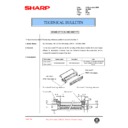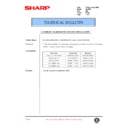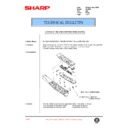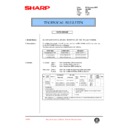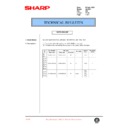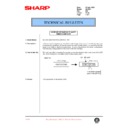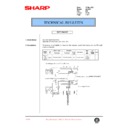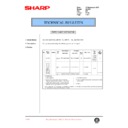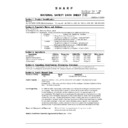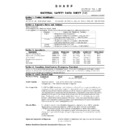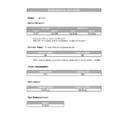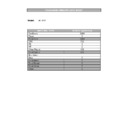Sharp AL-1000 / AL-1010 (serv.man11) Service Manual ▷ View online
(4) Features of copy density adjustment
For the copy density adjustment, the image data shift function
provided in the image process LSI is used.
provided in the image process LSI is used.
List of the adjustment modes
Auto Mode
Brightness 1 step only
Manual Mode
Brightness 5 steps. Adjustment of only
the center brightness is made.
the center brightness is made.
Photo Mode
Brightness 5 steps. Adjustment of only
the center brightness is made.
the center brightness is made.
Manual T/S
mode
mode
Brightness 5 steps. Adjustment of only
the center brightness is made.
the center brightness is made.
T/S Auto
mode
mode
Brightness 1 step only
(5) Copy density adjustment procedure
Use SIM 46-01 to set the copy density for each copy mode.
For selection of modes, use the copy mode select key.
For selection of modes, use the copy mode select key.
A. Test chart (UKOG-0162FCZZ) setting
1) Place the test chart so that its edge is aligned with the A4
(Letter) reference line on the document table. Then place a
B4 (14
B4 (14
″
×
8 1/2
″
) white paper on the test chart and close the
document cover.
B. Perform the adjustment in each mode.
(1) Execute SIM 46-1.
(2) Select the mode to be adjusted with the exposure mode
select key. Set the exposure level to 3 for all adjustment.
(Except for the auto mode.)
(Except for the auto mode.)
Adjustment
mode
Exposure mode
display lamp
Ex-
posure
level
Sharp gray chart
adjustment level
Auto mode
Auto lamp ON
—
“3” is slightly
copied.
copied.
Manual
mode
Manual lamp ON
3
“3” is slightly
copied.
copied.
Photo mode
Photo lamp ON
3
“3” is slightly
copied.
copied.
Manual T/S
mode
Manual
lamp/Photo lamp
ON
3
“4” is slightly
copied.
copied.
Auto T/S
mode
Auto lamp/Photo
lamp ON
3
“4” is slightly
copied.
copied.
(3) Make a copy.
Check the adjustment level (shown in the above table) of the
exposure test chart (Sharp Gray Scale).
exposure test chart (Sharp Gray Scale).
Sharp Gray Scale adjustment level
Non toner
save mode
Toner save
mode
(When too bright): Decrease the value displayed on the
copy quantity display.
(When too dark): Increase the value displayed on the copy
quantity display.
* The value can be set in the range of 1 — 99.
Test chart
White paper
(1)
(2)
(1) Mode select key/display
lamp
(2) Exposure level select
key/display lamp
1
10
W
2
3
4
5
6
7
8
9
Slightly copied.
Not copied.
1
10
W
2
3
4
5
6
7
8
9
Slightly copied.
Not copied.
AL-1000/1010
9-9
3. High voltage adjustment
(1) Main charger (Grid bias)
Note:
●
Use a digital multi meter with internal resistance of
10M
10M
Ω
or more measurement.
●
After adjusting the grid LOW output, adjust the HIGH
output. Do not reverse the sequence.
output. Do not reverse the sequence.
Procedures
1. Set the digital multi meter range to DC700V.
2. Set the positive side of the test rod to the connector CN11-3
2. Set the positive side of the test rod to the connector CN11-3
(GRID) of high voltage section of the power PWB and set
the negative side to the frame ground (radiating plate).
the negative side to the frame ground (radiating plate).
3. Execute SIM 8-3. (The main charger output is supplied for
30 sec in the grid voltage LOW output mode.)
4. Adjust the control volume (VR-141) so that the output volt-
age is –400
±
20V.
5. Execute SIM 8-2. (The main charger output is supplied for
30 sec in the grid voltage HIGH output mode.)
6. Adjust the control volume (VR-142) so that the output volt-
age is 580
±
10V.
(2) DV bias adjustment
Note:
●
A digital multi meter with internal resistance of 1G
Ω
must be use for correct adjustment.
Procedures
1. Set the digital multi meter range to DC500V.
2. Set the positive side of the test rod to the connector CN-10-
2. Set the positive side of the test rod to the connector CN-10-
1 (DV BIAS) and set the negative side to the connector
CN10-2 (FG).
CN10-2 (FG).
3. Execute SIM 8-1. (The developing bias is outputted for 30
sec.)
4. Adjust the control volume (VR-121) so that the output volt-
age is –400
±
5V.
AL-1000/1010
9-10
3. High voltage adjustment
(1) Main charger (Grid bias)
Note:
●
Use a digital multi meter with internal resistance of
10M
10M
Ω
or more measurement.
●
After adjusting the grid LOW output, adjust the HIGH
output. Do not reverse the sequence.
output. Do not reverse the sequence.
Procedures
1. Set the digital multi meter range to DC700V.
2. Set the positive side of the test rod to the connector CN11-3
2. Set the positive side of the test rod to the connector CN11-3
(GRID) of high voltage section of the power PWB and set
the negative side to the frame ground (radiating plate).
the negative side to the frame ground (radiating plate).
3. Execute SIM 8-3. (The main charger output is supplied for
30 sec in the grid voltage LOW output mode.)
4. Adjust the control volume (VR-141) so that the output volt-
age is –400
±
20V.
5. Execute SIM 8-2. (The main charger output is supplied for
30 sec in the grid voltage HIGH output mode.)
6. Adjust the control volume (VR-142) so that the output volt-
age is 580
±
10V.
(2) DV bias adjustment
Note:
●
A digital multi meter with internal resistance of 1G
Ω
must be use for correct adjustment.
Procedures
1. Set the digital multi meter range to DC500V.
2. Set the positive side of the test rod to the connector CN-10-
2. Set the positive side of the test rod to the connector CN-10-
1 (DV BIAS) and set the negative side to the connector
CN10-2 (FG).
CN10-2 (FG).
3. Execute SIM 8-1. (The developing bias is outputted for 30
sec.)
4. Adjust the control volume (VR-121) so that the output volt-
age is –400
±
5V.
AL-1000/1010
9-10
3. High voltage adjustment
(1) Main charger (Grid bias)
Note:
●
Use a digital multi meter with internal resistance of
10M
10M
Ω
or more measurement.
●
After adjusting the grid LOW output, adjust the HIGH
output. Do not reverse the sequence.
output. Do not reverse the sequence.
Procedures
1. Set the digital multi meter range to DC700V.
2. Set the positive side of the test rod to the connector CN11-3
2. Set the positive side of the test rod to the connector CN11-3
(GRID) of high voltage section of the power PWB and set
the negative side to the frame ground (radiating plate).
the negative side to the frame ground (radiating plate).
3. Execute SIM 8-3. (The main charger output is supplied for
30 sec in the grid voltage LOW output mode.)
4. Adjust the control volume (VR-141) so that the output volt-
age is –400
±
20V.
5. Execute SIM 8-2. (The main charger output is supplied for
30 sec in the grid voltage HIGH output mode.)
6. Adjust the control volume (VR-142) so that the output volt-
age is 580
±
10V.
(2) DV bias adjustment
Note:
●
A digital multi meter with internal resistance of 1G
Ω
must be use for correct adjustment.
Procedures
1. Set the digital multi meter range to DC500V.
2. Set the positive side of the test rod to the connector CN-10-
2. Set the positive side of the test rod to the connector CN-10-
1 (DV BIAS) and set the negative side to the connector
CN10-2 (FG).
CN10-2 (FG).
3. Execute SIM 8-1. (The developing bias is outputted for 30
sec.)
4. Adjust the control volume (VR-121) so that the output volt-
age is –400
±
5V.
AL-1000/1010
9-10














